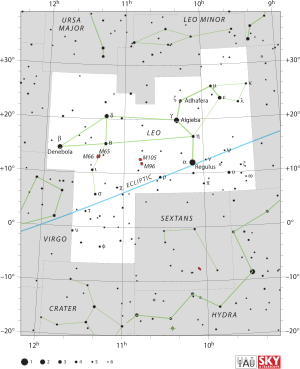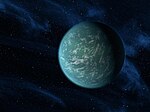HD 96063
| Observation data Epoch J2000.0[1] Equinox J2000.0[1] | |
|---|---|
| Constellation | Leo |
| Right ascension | 11h 04m 44.4548478744s[1] |
| Declination | −02° 30′ 47.590085736″[1] |
| Apparent magnitude (V) | 8.254[1] |
| Characteristics | |
| Spectral type | K0 |
| B−V color index | 0.836[1] |
| Astrometry | |
| Radial velocity (Rv) | −1.18[1] km/s |
| Proper motion (μ) | RA: 27.824[1] mas/yr Dec.: −17.902[1] mas/yr |
| Parallax (π) | 7.1787 ± 0.028 mas[1] |
| Distance | 454 ± 2 ly (139.3 ± 0.5 pc) |
| Details | |
| Mass | 1.37[2] M☉ |
| Radius | 4.75,[2] 3.33±0.45[3] R☉ |
| Luminosity | 8.91+3.97 −2.75[3] L☉ |
| Surface gravity (log g) | 3.33[2] cgs |
| Temperature | 5020[2] K |
| Metallicity [Fe/H] | −0.10±0.14[4] dex |
| Rotational velocity (v sin i) | 1.71±0.26,[3] 0.870±0.500[5] km/s |
| Age | 2.92±0.81[3] Gyr |
| Other designations | |
| Database references | |
| SIMBAD | data |
HD 96063 (proper name Dingolay) is a 8th-magnitude red-giant branch star located about 454 light-years (139 pc) away in the constellation of Leo.[6][1] It is orbited by one confirmed exoplanet, HD 96063 b (proper name Ramajay), a gas giant slightly larger and more massive than Jupiter.[5]
Nomenclature
[edit]In 2019, the Republic of Trinidad and Tobago was assigned to giving the HD 96063 system a proper name as part of the IAU100 NameExoWorlds Project, planned to celebrate the hundredth anniversary of the International Astronomical Union (IAU), which grants the right to name an exoplanetary system to every state and territory in the world.[6] Names were submitted and selected within Trinidad and Tobago, which were then presented to the IAU to be officially recognized.[7] On 17 December 2019, the IAU announced that HD 96063 and its planet, b, were named Dingolay and Ramajay, respectively.[8]
The two names are both derived from terms related to the Trinidad and Tobago Carnival. Dingolay is a dance form that represents the culture and language of Trinidad and Tobago's ancestors via intricate movements. Ramajay is a steelpan style of singing and music that celebrates Trinidad and Tobago's forefathers' culture and language.[8]
Stellar characteristics
[edit]HD 96063 is an evolved yellow/orange star with an effective temperature of about 5,000–5,100 K,[2][9] typical of stars entering the red-giant branch. Its precise nature, however, has been controversial. Once classified as a G6-type main-sequence star,[10] the star is more recently thought to be a K-type "yellow giant,"[11][12] somewhere between three and five times as large as the Sun.[3][2] When the planet HD 96063 b was discovered, the star was assumed to be 9.0±3.0 billion years old with a sun-like mass (1.020±0.072 M☉),[5] but subsequent studies consider it to be more massive at about 1.4 M☉, and thus younger (2.92±0.81 Gyr).[3] With a luminosity roughly ten times that of the Sun and a distance of 454 light-years, the star has an apparent magnitude of 8.254, too faint to be seen from Earth by the naked eye.[4][1]
Planetary system
[edit]In 2011, radial-velocity observations made at the W. M. Keck Observatory revealed the existence of an exoplanet around HD 96063.[5] The planet, HD 96063 b, is thought to be a gas giant at least 1.265 times the mass of Jupiter, which orbits its host star at a distance of 1.11 AU with an Earth-like period of 362 days. Its orbit is moderately eccentric, with an eccentricity comparable to that of planet Mercury (0.2056).[2][13]
| Companion (in order from star) |
Mass | Semimajor axis (AU) |
Orbital period (days) |
Eccentricity | Inclination | Radius |
|---|---|---|---|---|---|---|
| b (Ramajay) | ≥ 1.265 MJ | 1.11 | 362.518 ± 2.162 | 0.168 ± 0.107 | — | 1.242 RJ |
See also
[edit]- List of proper names of stars
- List of proper names of exoplanets
- List of stars in Leo
- List of exoplanets discovered in 2011
References
[edit]- ^ a b c d e f g h i j k l "HD 96063 -- Star". SIMBAD. CDS. Retrieved 27 August 2019.
- ^ a b c d e f g h Luhn, Jacob K.; Bastien, Fabienne A.; Wright, Jason T.; Johnson, John A.; Howard, Andrew W.; Isaacson, Howard (1 April 2019). "Retired A Stars and Their Companions. VIII. 15 New Planetary Signals around Subgiants and Transit Parameters for California Planet Search Planets with Subgiant Hosts". The Astronomical Journal. 157 (4): 149. arXiv:1811.03043. Bibcode:2019AJ....157..149L. doi:10.3847/1538-3881/aaf5d0. ISSN 0004-6256.
- ^ a b c d e f Jofré, E.; Petrucci, R.; Saffe, C.; Saker, L.; Artur de la Villarmois, E.; Chavero, C.; Gómez, M.; Mauas, P. J. D. (2015). "Stellar parameters and chemical abundances of 223 evolved stars with and without planets". Astronomy & Astrophysics. 574: A50. arXiv:1410.6422. doi:10.1051/0004-6361/201424474. ISSN 0004-6361.
- ^ a b Stassun, Keivan G.; Oelkers, Ryan J.; Paegert, Martin; Torres, Guillermo; Pepper, Joshua; Lee, Nathan De; Collins, Kevin; Latham, David W.; Muirhead, Philip S.; Chittidi, Jay; Rojas-Ayala, Bárbara; Fleming, Scott W.; Rose, Mark E.; Tenenbaum, Peter; Ting, Eric B.; Kane, Stephen R.; Barclay, Thomas; Bean, Jacob L.; Brassuer, C. E.; Charbonneau, David; Ge, Jian; Lissauer, Jack J.; Mann, Andrew W.; McLean, Brian; Mullally, Susan; Narita, Norio; Plavchan, Peter; Ricker, George R.; Sasselov, Dimitar; Seager, S.; Sharma, Sanjib; Shiao, Bernie; Sozzetti, Alessandro; Stello, Dennis; Vanderspek, Roland; Wallace, Geoff; Winn, Joshua N. (1 October 2019). "The Revised TESS Input Catalog and Candidate Target List". The Astronomical Journal. 158 (4): 138. arXiv:1905.10694. doi:10.3847/1538-3881/ab3467. ISSN 0004-6256.
- ^ a b c d Johnson, John Asher; Clanton, Christian; Howard, Andrew W.; Bowler, Brendan P.; Henry, Gregory W.; Marcy, Geoffrey W.; Crepp, Justin R.; Endl, Michael; Cochran, William D.; MacQueen, Phillip J.; Wright, Jason T.; Isaacson, Howard (1 December 2011). "Retired a Stars and Their Companions. Vii. 18 New Jovian Planets". The Astrophysical Journal Supplement Series. 197 (2): 26. arXiv:1108.4205. Bibcode:2011ApJS..197...26J. doi:10.1088/0067-0049/197/2/26. ISSN 0067-0049.
- ^ a b "List of stars and planets". Name ExoWorlds. IAU. Retrieved 27 August 2019.
- ^ "Methodology". Name ExoWorlds. IAU. Retrieved 27 August 2019.
- ^ a b "Approved names". NameExoWorlds. IAU. Retrieved 24 December 2019.
- ^ Brown, A. G. A.; et al. (Gaia collaboration) (August 2018). "Gaia Data Release 2: Summary of the contents and survey properties". Astronomy & Astrophysics. 616. A1. arXiv:1804.09365. Bibcode:2018A&A...616A...1G. doi:10.1051/0004-6361/201833051. Gaia DR2 record for this source at VizieR.
- ^ Houk, Nancy; Swift, Carrie (2000) [1999]. "Michigan catalogue of two-dimensional spectral types for the HD Stars ; vol. 5". VizieR Online Data Catalog. Bibcode:1999MSS...C05....0H.
- ^ "Trinidad and Tobago | IAU100 Name ExoWorlds". IAU. Retrieved 16 September 2024.
- ^ "HD 96063 b - NASA Science". Retrieved 6 September 2024.
- ^ Williams, David R. (25 November 2020). "Mercury Fact Sheet". NASA. Archived from the original on 3 April 2019. Retrieved 19 April 2021.
External links
[edit]- Jean Schneider. "Planet HD 96063 b". The Extrasolar Planet Encyclopaedia. Retrieved 16 September 2024.
- "HD 96063 Overview". NASA Exoplanet Archive. Retrieved 16 September 2024.
- HD 96063 on WikiSky: DSS2, SDSS, GALEX, IRAS, Hydrogen α, X-Ray, Astrophoto, Sky Map, Articles and images




